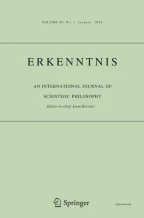Abstract
The distinction between basic and applied research is notoriously vague, despite its frequent use in science studies and in science policy. In most cases it is based on such pragmatic factors as the knowledge and intentions of the investigator or the type of research institute. Sometimes the validity of the distinction is denied altogether. This paper suggests that there are two ways of distinguishing systematically between basic and applied research: (i) in terms of the “utilities” that define the aims of inquiry, and (ii) by reference to the structure of the relevant knowledge claims. An important type of applied research aims at results that are expressed by “techical norms” (in von Wright's sense): if you wish to achieveA, and you believe you are in a situationB, then you should doX. This conception of “design sciences” allows us to re-evaluate many issues in the history, philosophy, and ethics of science.
Similar content being viewed by others
References
Ackoff, R. L. (with collaboration of S. K. Gupta and J. S. Minas): 1962,Scientific Method: Optimizing Applied Research Decisions, John Wiley, New York.
Bugliarello, G. and Doner, D. B. (eds.): 1979,The History and Philosophy of Technology, University of Illinois Press, Urbana.
Bunge, M.: 1966, ‘Technology as Applied Science’,Technology and Culture 7, 329–349. (Reprinted in Rapp (1974), pp. 19–36.)
Bunge, M.: 1979, ‘The Philosophical Richness of Technology’, in Bugliarello and Doner (1979), pp. 262–281.
Dreyfus, H. L. and SE: 1986,Mind over Machine: The Power of Human Intuition and Expertise in the Era of the Computer, Blackwell, Oxford.
Elzinga, A.: 1985, ‘Research, Bureaucracy and the Drift of Epistemic Criteria’, in B. Wittrock and A. Elzinga (eds.),The University Research System, Almqvist & Wiksell, Stockholm.
Gasparski, N.et al.: 1983, ‘Contemporary History of Design Science’,Praxeology Yearbook 3, 147–156.
Habermas, J.: 1971,Knowledge and Human Interest, Beacon Press, Boston.
Held, D.: 1980,Introduction to Critical Theory, University of California Press, Berkeley.
Irvine, I. and Martin, B.: 1984,Foresight in Science: Picking the Winners, Francis Pinter, London.
Latour, B.: 1987,Science in Action, Open University Press, Milton Keynes.
Laudan, L.: 1987, ‘Progress or Rationality’,American Philosophical Quarterly 24, 19–31.
Leplin, J. (ed.): 1984,Scientific Realism, University of California Press, Berkeley.
Levi, I.: 1967,Gambling With Truth, Alfred A. Knopf, New York. (2nd ed. The MIT Press, Cambridge, Mass. 1973.)
Levi, I.: 1980,The Enterprise of Knowledge, The MIT Press, Cambridge, Mass.
Lindblom, C. E. and Cohen, D. K.: 1979,Usable Knowledge: Social Science and Social Problem Solving, Yale University Press, New Haven.
Longino, H. E.: 1989, ‘Biological Effects of Low-Level Radiation: Values, Dose-Response Models, Risk Estimates’,Synthese 81, 391–404.
Mitcham, C.: 1979, ‘Philosophy and the History of Technology’, in Bugliarello and Doner (1979), pp. 163–201.
Mitcham, C. and Mackey, R. (eds.): 1983,Philosophy and Technology, Macmillan, New York.
Mulkay, M.: 1979,Science and the Sociology of Knowledge, Allen & Unwin, London.
Niiniluoto, I.: 1984a,Is Science Progressive?, D. Reidel, Dordrecht.
Niiniluoto, I.: 1984b, ‘Philosophical Perspectives on Design’, in S. Vihma (ed.),Designforschung, Design Research, University of Industrial Arts, Helsinki, pp. 13–31.
Niiniluoto, I.: 1985a, ‘Edistyminen soveltavissa in tieteissä’, in E. Kaukonenet al. (eds.),Tieteen historia ja tieteen edistyminen, Suomen Akatemian julkaisuja 2, Helsinki, pp. 169–192.
Niiniluoto, I.: 1985b, ‘Truth and Legal Norms’, in N. MacCormicket al. (eds.),Conditions of Validity and Cognition in Modern Legal Thought, ARSP, Beiheft 25, Franz Steiner Verlag, Wiesbaden, pp. 168–190.
Niiniluoto, I.: 1987a,Truthlikeness, D. Reidel, Dordrecht.
Niiniluoto, I.: 1987b, ‘Soveltavat tieteet tieteenfilosofian näkökulmasta’, inAcademia Scientiarum Fennica – Year Book 1986–1987, Helsinki, pp. 137–142.
Niiniluoto, I.: 1990a, ‘Science and Epistemic Values’,Science Studies 3:1 (1990), 21–25.
Niiniluoto, I.: 1990b, ‘Should Technological Imperatives be Obeyed?’,International Studies in the Philosophy of Science 4:2, 181–189.
Niiniluoto, I.: 1992, ‘Descriptive and Inductive Simplicity’, forthcoming the Proceedings of the Carnap-Reichenbach Symposium, Konstanz, May 1991.
Popper, K.: 1963,Conjectures and Refutations, Routledge and Kegan Paul, London.
Rapp, F. (ed.): 1974,Contributions to a Philosophy of Technology, D. Reidel, Dordrecht.
Rescher, N. (ed.): 1990,Aesthetic Factors in Natural Science, University Press of America, Lanham.
Restivo, S. and Loughlin, J.: 1987, ‘Critical Sociology of Science and Scientific Validity’, inKnowledge: Creation, Diffusion, Utilization, vol. 8:3, pp. 486–508.
Schäfer, W. (ed.): 1983,Finalization in Science, D. Reidel, Dordrecht.
Simon, H.: 1969,The Sciences of the Artifcial, The MIT Press, Cambridge, Mass. (2nd ed. 1982.)
Sintonen, M.: 1990, ‘Basic and Applied Sciences-Can the Distinction (Still) Be Drawn?’,Science Studies 3:2 (1990), 23–31.
Skolimowski, H.: 1966, ‘The Structure of Thinking in Technology’,Technology and Culture 7, 371–383. (Reprinted in Rapp (1974), pp. 72–85.)
Stegmüller, W.: 1969,Wissenschaftliche Erklärung und Begründung, Springer-Verlag, Berlin.
Tuomela, R.: 1985,Science, Action, and Reality, D. Reidel, Dordrecht.
von Wright, G. H.: 1963,Norm and Action, Routledge and Kegan Paul, London.
von Wright, G. H.: 1983,Practical Reason, Blackwell, Oxford.
von Wright, G. H.: 1986,Vetenskapen och förnuftet, Söderström, Borgå.
Author information
Authors and Affiliations
Rights and permissions
About this article
Cite this article
Niiniluoto, I. The aim and structure of applied research. Erkenntnis 38, 1–21 (1993). https://doi.org/10.1007/BF01129020
Received:
Issue Date:
DOI: https://doi.org/10.1007/BF01129020
